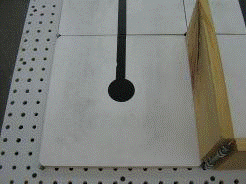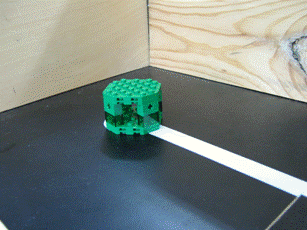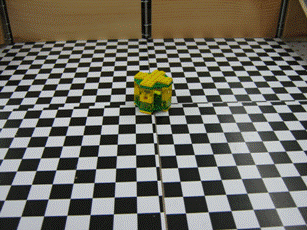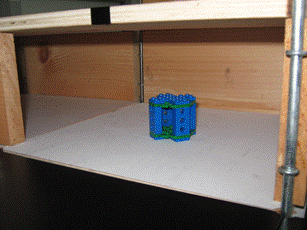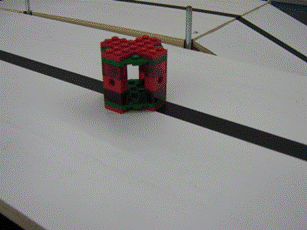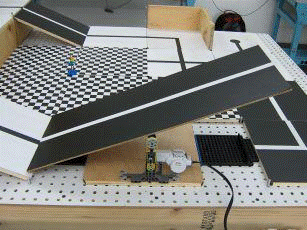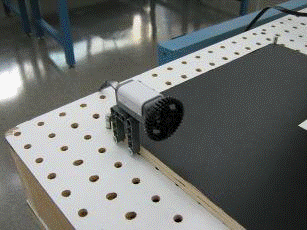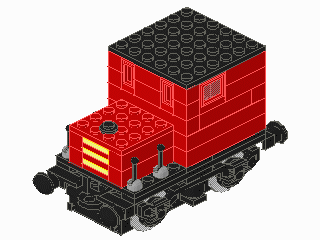Search & Recovery Robot (SRR)
RFP*: Space Station Autonomous Robot (SSAR)
* RFP is an acronym for Request For Proposal. Internationally, RFPs are called ITTs, an acronym for Invitation To Tender. Companies and governmental agencies use RFPs to solicit new business.
INTRODUCTION AND OVERVIEW
In 2007, meteor Billy1987 collided with the International Space Station (ISS). The ISS orbits the moon and is a research facility assembled in space and formed among the space agencies of the US, Russia, Japan, Canada and eleven European countries. During the collision, several pieces of the ISS landed on the Moon, including “Zarya�?, the power supply module. NASA has issued an RFP for the development of a cost-effective autonomous robot that will retrieve Zarya. The robot should be compact in size in order to fit into the space shuttle. It will be released from the shuttle, land on the moon, traverse through the debris, retrieve Zarya, and return back to its landing site where it will take off back to the space shuttle.
SPECIFICATIONS
Design a robot using MLCad as your primary design tool. Your team must build a model of your design using the materials provided. A Mindstorms program that will direct the robot's movements must be created. A cost estimate of the robot's components must be provided. All revisions to the original design must be recorded and explained. This includes technical design drawings, as well as cost estimates. All revisions to the Mindstorms program must be recorded and explained.
The SSAR must be able to move autonomously over a pre-selected route, retrieve the power supply module Zarya, and returning them to the space shuttle (start point). Students are allowed to assist their robot in retrieval of Zarya, as long as a part of the robot is overhanging the tile where Zarya can be found at the start of the simulation. For extra credit, the robot may retrieve specific modules that have fallen off the ISS. The robot must fit in a start area that is 25cm long by 25cm wide. There is no height restriction. These specifications must be met for final commissioning.
Projectile (catapult, slingshot) designs are not allowed.
The robot program may not be altered or switched during any part of the mission. Likewise, the robot must be fully autonomous, and therefore cannot be touched by any person during testing. Please refer to the course syllabus for all due dates.
The robot must return to the space shuttle for the robot to successfully complete the project.
Note: Any student who attempts to alter the course in any way, shape, or fashion (this includes lifting a tile to inspect its design) must meet with the Course Director to explain your attempt at academic dishonesty.
ROUTE CHOICES
The starting point is indicated by the tile in Figure 1.
Figure 1: SSAR Landing Site
Note: The picture above contains one representation of this
project description.
Actual course may be different from the one pictured above,
but similar in objective.
Your robot must retrieve Zarya (green module) shown in Figure 2.
Figure 2: Zarya
Note: The picture above contains one representation of this
project description.
Actual course may be different from the one pictured above,
but similar in objective.
Route 1: The robot must activate and travel across the Solar Panel.
Figure 3: Solar panel route view
Note: The picture above contains one representation of this
project description.
Actual course may be different from the one pictured above,
but similar in objective.
Route 2: The robot must traverse the tunnel formed from the debris of the collision.
Figure 4: Tunnel route view
Note: The picture above contains one representation of this
project description.
Actual course may be different from the one pictured above,
but similar in objective.
Extra Credit
Extra credit is awarded to students who build a robot that retrieves modules back to the space shuttle. The point breakdown for any extra credit is outlined in the EG1004 Grading Policy.
Figure 5: Unity (Node 1)
Figure 6: Quest (Joint Airlock)
Figure 7: Pirs (Docking Compartment)
Extra credit will also be awarded if you cross the “Spilled Fuel�? or if you traverse the “Solar Panel�? after pushing the button.
Figure 8: Spilled Fuel
Note: The picture above contains one representation of this
project description.
Actual course may be different from the one pictured above,
but similar in objective.
Figure 9: Solar Panel
Note: The picture above contains one representation of this
project description.
Actual course may be different from the one pictured above,
but similar in objective.
Figure 10: Button to activate Solar Panel
Note: The picture above contains one representation of this
project description.
Actual course may be different from the one pictured above,
but similar in objective.
If you would like to design your own route, you may ask your instructor for permission.
Creativity and innovation are always rewarded. Original designs will receive extra credit.
MICROSOFT PROJECT
Your team must create a time management plan using Microsoft Project (MS Project). You can learn Microsoft Project by doing the MS Project Skill Builder contained elsewhere in this manual. This plan must include all tasks related to the project. Each task must be named, assigned duration and assigned to a specific person (or people). You must begin your work by creating an MS Project plan. Follow your project plan throughout the semester. If the team falls behind schedule, explain the reasons for the delays when you present your progress reports, list the steps being taken to get the project back on track, and create a revised MS Project plan.
For help in planning your project, review the page called How to plan the schedule and calculate costs for a project in the section called Material to help you with the project elsewhere in this manual.
There should be at least twenty tasks/subtasks and three Milestones. Milestones should be noted with the duration of "0day". Moreover, the copy picture function included in MS Project Software should be used instead of the print screen function of the computer.
DRAWINGS
A command of MLCad is necessary for you to complete the drawings required for this project. Use MLCad to create four drawings of your robot: front, top, most detailed side, and a drawing of your gear trains. Sensors, motors, and gears must be included in each drawing. All parts used in the robot must be referred to using the part number found in the price list.
Each revision of your design must be documented. This is done by saving the old side view drawing, and assigning a revision number to the new drawing.
NXT Parts
Since NXT is a very recent technology upgrade to Mindstorms, the NXT parts have not been fully reviewed for inclusion in the "official" parts library for MLCad. There are unofficial versions of the parts available for use in MLCad. You can download the parts using the following links:
- Watch this space for links
Figure 6: Sample isometric image from MLCad (without part numbers)
MATERIALS
The following materials will be provided:
- Mindstorms NXT part kit
- One NXT
- Sensors
- Motors
Additional materials can be supplied by your TA.
COST ESTIMATE
Once a robot design is complete, a cost estimate must be generated that specifies the cost of all the materials and labor required for the construction of your design. Tabulate this cost information clearly in an Excel spreadsheet, using the materials cost list provided. You can get help in calculating the cost by reviewing the page called How to plan the schedule and calculate costs for a project in the section called Material to help you with the project elsewhere in this manual. The costs for the parts can be found on the page [list for Lego parts for robot projects] in the Material to help you with the project section elsewhere in this manual.
Note: You should only use the materials contained in the [list for Lego parts for robot projects]. If you want to use other parts, get permission from your faculty member to do so, and also to determine the cost of the parts you want to use that are not in this price list.
Have all the materials and parts used categorized in different groups instead of including individual parts. Make sure to include the units of each part used in a group and total them up for that individual group. Moreover, the cost of labor should be included. You can get help on the labor cost by reading the page How to plan the schedule and calculate costs for a project in the section called Material to help you with the project elsewhere in this manual.
MILESTONES
As you work on your project, you will be required to present periodic reports on your progress. We call these Milestones. All the items assigned in each Milestone are called deliverables. These deliverables often consist of a combination of written submissions, presentations, and demonstrations.
Milestone 1
Prepare a preliminary sketch of your design, a cost estimate, and an MS Project plan. Also, indicate which route you plan to follow from the start line to the treasure chest.
Look Ahead: What tasks do you plan between now and Milestone 2?
Milestone 1 Deliverables: A presentation. Include the preliminary sketch, cost estimate, and MS Project plan. Include a brief description of the robot, the route to be followed, and any special features and benefits of your design.
Note: Whenever you revise your drawing(s), your cost estimate, or your MS Project plan, you must include the initial drawing, the initial cost estimate, or the initial MS Project plan, in addition to the revision.
Milestone 2
Using MLCad, prepare four views of your latest design: front, top, most detailed side, and an isometric drawing. Create an MLCad drawing of your gear trains. Complete your latest Mindstorms program and your latest MS Project plan reflecting any schedule changes. Finally, calculate a revised cost estimate. A signed Component Testing Form must be submitted to your Recitation TA.
Look Ahead: What tasks do you plan between now and Milestone 3?
Milestone 2 Deliverables: A copy of your presentation slides that includes four views of your design using MLCad: front, top, most detailed side, and an isometric drawing; an MLCad drawing of your gear trains; your Mindstorms program; a revised cost estimate; your revised MS Project plan; and your signed Component Testing Form.
Note: Whenever you revise your drawing(s), your cost estimate, or your MS Project plan, you must include the initial drawing, the initial cost estimate, or the initial MS Project plan, in addition to the revision.
Milestone 3
Using MLCad, prepare four views of your latest design: front, top, most detailed side, and an isometric drawing. Create an MLCad drawing of your gear trains. Complete your latest Mindstorms program and your latest MS Project plan reflecting any schedule changes. Finally, calculate a revised cost estimate.
Look ahead: What tasks do you plan between now and the completion of the project?
Milestone 3 Deliverables: A copy of your presentation slides that includes four views of your design using MLCad: front, top, most detailed side, and an isometric drawing; an MLCad drawing of your gear trains; your Mindstorms program; a revised cost estimate; and your revised MS Project plan.
Note: Whenever you revise your drawing(s), your cost estimate, or your MS Project plan, you must include the initial drawing, the initial cost estimate, or the initial MS Project plan, in addition to the revision.
FINAL PRESENTATION
The exact specifications for your final presentation will be provided by your instructor. Some of these requirements will be: the features and benefits of your design, project specifications, all drawings, Mindstorms programs, cost estimates, and your completed MS Project. Ideally, commissioning should take place before the Final Presentation. If, for some reason, you were not commissioned, then you may do so after the presentation. A signed Commissioning Statement must be included with your final presentation materials.
Final Submission
Your project should be submitted as a folder containing the following deliverables:
- Component testing statement
- Commissioning statement
- Hardcopy and CD containing:
- Final presentation
- Cover page and table of appendices.
- Appendices:
- Final Mindstorms program
- Initial sketch
- All the drawings of your final design
- Video
- Final MS Project Schedule
- Final Cost estimate
- Resume(s)
EARLY ACCEPTANCE
If you complete your project one week early, you are eligible for a bonus that will be added to your final semester-long project grade. You must submit all deliverables by 5PM one week before your section is scheduled to present (see syllabus for exact date). To commission early, all required information on the form titled Project Submission Form, found on the EG web site, must be approved, accepted, and signed by a TA. The deliverables received early are the ones you will use in your presentation. No adjustments to the deliverables commissioned will be accepted.
LIQUIDATED DAMAGES
If you do not complete all your deliverables and do not commission during the Final Presentation, you will incur liquidated damages as defined in the grading policy.
